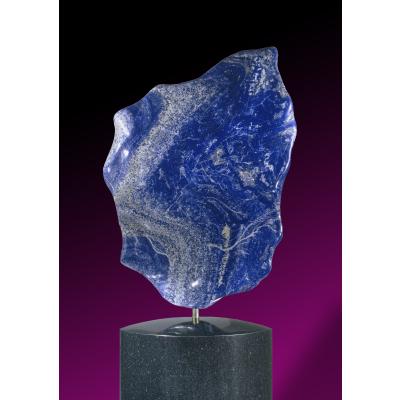
Posted in: Exhibitions
 On view at the Smithsonian, the "Blue Flame" Lapis lazuli is one of a number of Objects of Wonder. This massive slab of lapis weighs an astonishing 250 pounds! Photo courtesy Smithsonian National Museum of Natural History.
Objects of Wonder represents the magnitude and magnificence of the entire collection housed at the Smithsonian National Museum of Natural History. The Smithsonian prides itself in its offering of real objects. These collections offer researchers, cultural communities, and the broader community of Americans and foreigners to experience history through the eyes of important artifacts. To that end, this exhibit's curators assembled an awe-inspiring array of the museum's most rare and astonishing objects to present to the public.
On view at the Smithsonian, the "Blue Flame" Lapis lazuli is one of a number of Objects of Wonder. This massive slab of lapis weighs an astonishing 250 pounds! Photo courtesy Smithsonian National Museum of Natural History.
Objects of Wonder represents the magnitude and magnificence of the entire collection housed at the Smithsonian National Museum of Natural History. The Smithsonian prides itself in its offering of real objects. These collections offer researchers, cultural communities, and the broader community of Americans and foreigners to experience history through the eyes of important artifacts. To that end, this exhibit's curators assembled an awe-inspiring array of the museum's most rare and astonishing objects to present to the public.
Objects of Wonder
In total, the Smithsonian houses over 145 million specimens and artifacts. Many of these specimens remain persistently behind the scenes, accessible only to researchers and cultural specialists for study. According to Mary Jo Arnoldi, co-curator of Objects of Wonder, whether the specimens are too big, too fragile, or outside the scope of the narrative the revolving exhibits tell, the public rarely sees them. So Mary Jo and her fellow curators culled the Smithsonian's vast vault and brought out a few hundred rarely seen, yet keenly fascinating curiosities for the public to enjoy. Among the most beautiful specimens on display is the 'Blue Flame' Lapis lazuli.The Blue Flame
Ultramarine rock streaked through with veins of white calcite. This massive mineral slab resembles a space-eye view of Earth's oceans. Weighing in at 250 pounds, this exquisite specimen remains one of the largest gem-quality Lapis sample in the world. Lapis lazuli enjoys a long history of providing the raw materials for ancient artists to create paint. In fact, the stone has been used throughout history, dating back to the Neolithic period (4500 BC). When crushed and combined with binding agents, Lapis makes the coveted ultramarine blue paint. Not surprisingly, the name Lapis comes from the Persian word lazhward, which means 'blue'. This particular specimen hails from the Hindu Kush mountains in the northeastern corner of Afghanistan. In fact, this remote region of Afghanistan produces the majority of the world's supply of Lapis. With its difficult terrain, miners use mules to transport many of the specimens found, including the Blue Flame. (source)Prepare to be Awestruck
The curators of Objects of Wonder hope this unparalleled offering of some of the museum's most amazing specimens will spark curiosity and inspire awe in all those who visit. If you have ever wanted to walk through the vast vaults of the museum's collections, this is your opportunity. In addition to the Blue Flame, Objects of Wonder includes one of the largest collections of exotic wood in the world. Coupled with photographs demonstrating their beauty at a cellular level, some of the woods on display include Qulina negrensis, Cornus controversa, Cornus stolonifera, and Colubrina arborescens. The exhibition also features a rare and beautiful collection of Coleoptera species (beetles). The sheer diversity among beetles and their prolific existence on earth visually demonstrates the diversity between all types of insects. Yet another astonishing portion of the exhibit includes an extensive collection of more than 50,000 cowrie shells. For thousands of years, cowrie shells, with their intricate patterns and various colors, have been used as ornaments, currency, and ritual objects. Furthermore, they represent an important element of understanding reefs specifically, and marine life in general. These and more provide visitors to the Smithsonian with an exceptionally rare opportunity to personally experience a behind-the-scenes tour. This exhibition extends through 2021. To plan your visit, I invite you to visit the Smithsonian's website. ~Angela Magnotti Andrews5 years ago
21 view(s) 